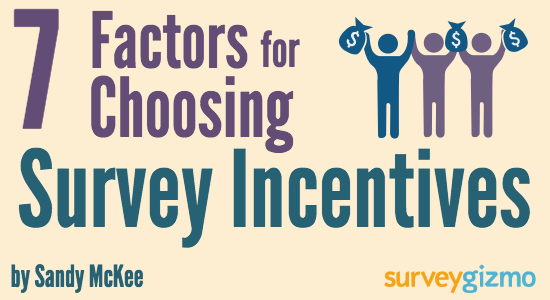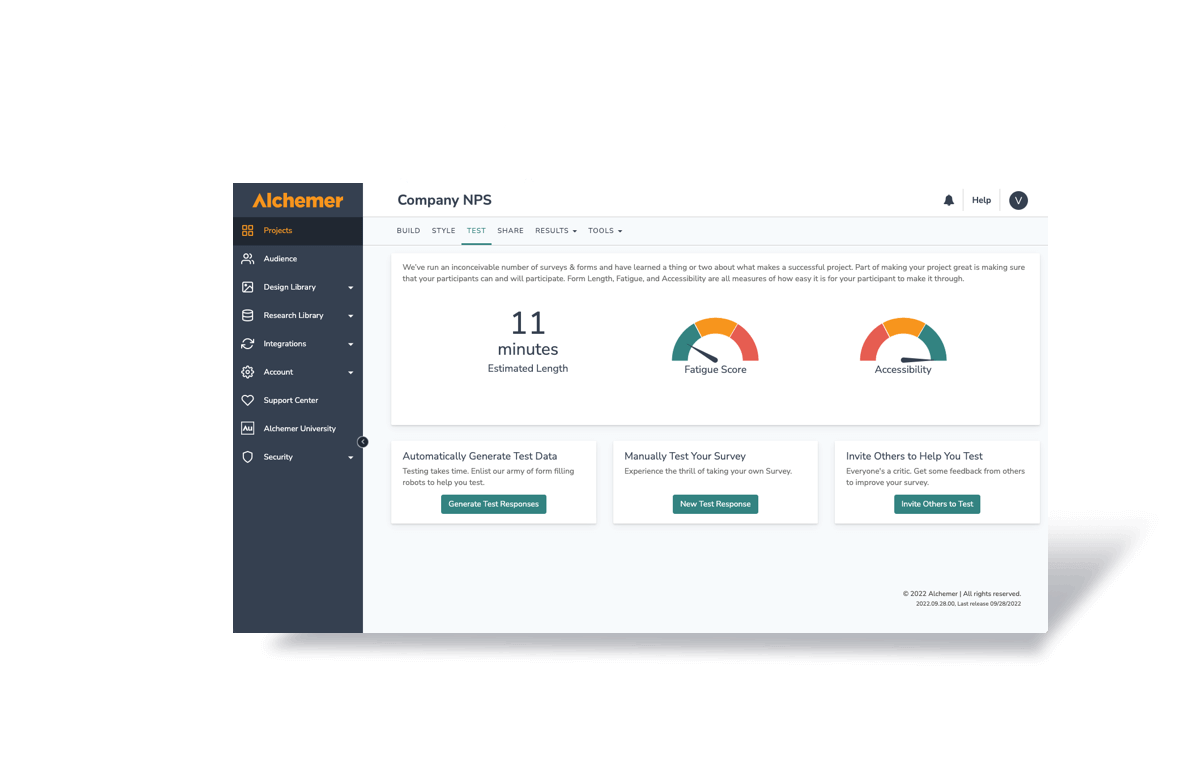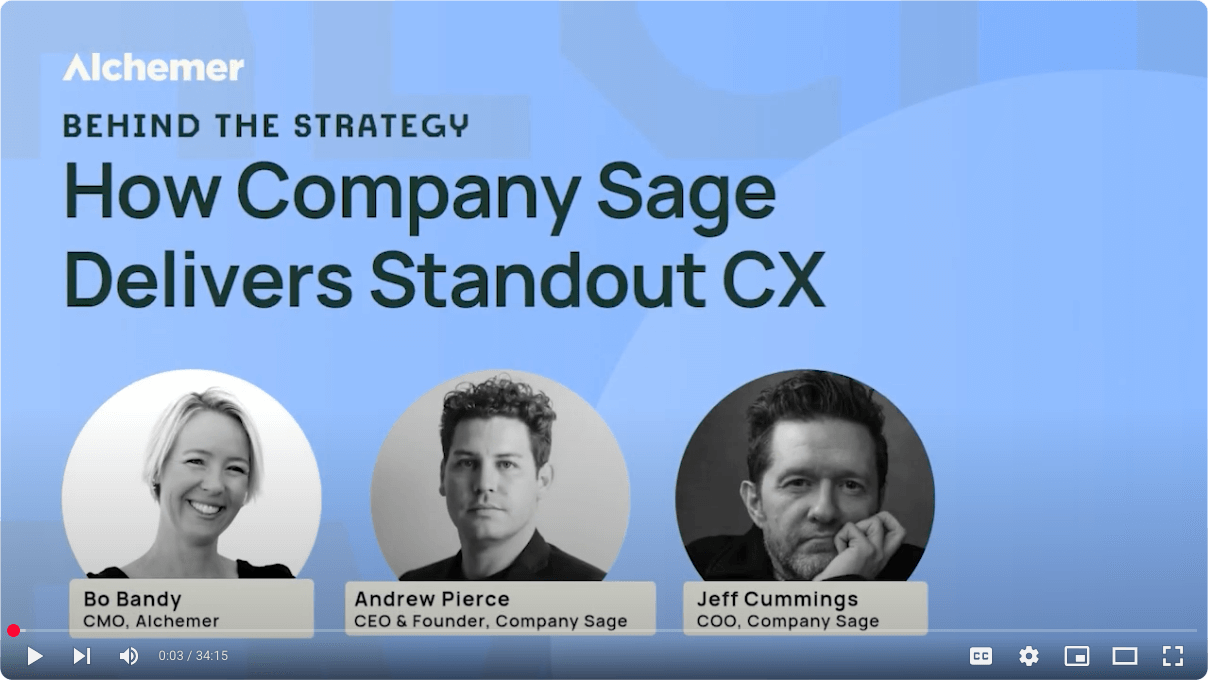
Offeringan incentive to respondents can significantly boost your response rate. However, it may also skew your data and consume a large portion of your budget. By choosing a relevant and enticing incentive, you can safeguard both your budget and your data quality.
Before creating a survey incentive, it’s important to consider your audience’s preferences. Decide on offering a lottery entry and determine the best way to deliver your incentive to respondents. You’ll also want to consider the timing of your offer, along with several other key factors.
This detailed guide will help you make the right choice for your survey incentive. It also includes an example of how one Alchemer user boosted their response rate from 2.2% to 11.5% using a cost-effective incentive.
Survey Incentives: 7 Key Factors
Each of these will have a unique impact on your own survey project, so take a careful look at each one to make sure your incentive will entice rather than repel.
1. Your Budget
This will be the most important factor to consider for most of us. Know what you can afford and set a quote on your responses so that you don’t inadvertently exceed your budget.
For example, if you offer free noise-cancelling headphones to the first 250 respondents, make sure only 250 people can access the survey. Alternatively, ensure that respondents after 250 don’t see the incentive message.
The worst case scenario is to neglect the quota and come back to a survey that has 2,500 responses, all of which were promised free headphones.
Keep a tight reign on your messaging by setting a response quota.
2. Incentive Type
Decide whether every respondent will receive the incentive or if only successful responses will earn an entry into a lottery. This choice determines whether each participant is guaranteed a reward or just a chance to win.
Lottery-style incentives generally have a higher monetary value than those given to all respondents. Recently, iPads have become a popular choice for these types of incentives. This method is effective for increasing response rates. However, since the incentive has a higher monetary value, it can sometimes come across as a bribe.
Clear messaging about the lottery is vital with these kinds of incentives. You want to be clear that everybody doesn’t get an iPad, just the chance to win one. This can also help cut down on the appearance of paying for responses.
3. Your Audience
Keep your audience’s motivations front and center during the incentive-choosing process. You don’t want to offer items that are valueless for your respondents. Instead, your incentive should be something they appreciate and something that is easily accessible to the majority of your survey’s audience.
Studies have shown that cash incentives offer the highest response rates, but handing out cash isn’t always practical, particularly in an online survey.1
Gift cards and coupon codes, in contrast, can be distributed instantly and are easy for respondents to redeem. This is especially true if they’re from an online shopping site that isn’t limited by geographic location.
4. Delivery Method
Make sure that the incentive that you choose is easy to deliver and redeem.
As I mentioned above, these factors are why so many people choose gift cards and coupon codes as rewards for respondents. These can be easily sent to the respondent with an automated email action immediately following the completion of the survey.
Delivering the code through SMS text messaging, as we’ll see in our case study, is also a convenient method of delivery and retrieval.
5. When to Offer the Incentive
It’s important to decide if you’ll offer the incentive as soon as the survey begins, or only after a successful completion.
Surprisingly, incentives offered up front have been shown to increase response more effectively than those promised for completing the survey:
“Researchers with the US Department of Veterans Affairs found that the promise of a $5.00 cash incentive increased response rates by 30% and actually providing the $5.00 up front increased response rates by 50%”2
Apparently once the respondent receives the incentive, they feel obligated to complete the survey.
6. Quality Control
If your respondents like your incentive, there’s a good chance they’ll try to collect on it multiple times by taking your survey more than once. To avoid duplicate responses, be sure that your survey software offers a feature like vote protection that will block people from returning to take it again.
Also, make sure that the right people are getting your incentive. Use disqualifying logic early in your survey to filter out respondents who don’t meet your criteria. It would be a waste to pay for an incentive on a response you can’t use.
For instance, if your survey is about your last event, ensure that only those who attended qualify for the incentive. Ask respondents upfront if they attended all the sessions of your event to confirm their eligibility.
Logic will give you cleaner results and a lower incentive budget.
7. Anonymous Surveys
If you’re conducting an anonymous survey, adding an incentive is a bit trickier, but not impossible.
The best way is to create a redirect action at the end of your survey that sends a respondent to a second survey that will collect their contact information. Then you can provide them their prize without needing to associate contact details with their survey data.
Case Study of Affordable Survey Incentive Success: DocPIES and txtMovies
The size of your incentive should be high enough to peak interest but low enough that it doesn’t unduly affect the answers. Used correctly, low cost incentives can give you the right number of responses to meet your sample size without tainting the results.
DocPIES found this to be very true when they began offering a $1.99 Redbox movie rental coupon code through txtMovies as a survey incentive. Using this incentive they saw a 77% increase in the click rate of their email invitation and a 326% increase in their response rate.
Testing the Effectiveness of Survey Incentives
DocPIES describe their efforts like this:
Recently we tested the use of survey incentives to determine if we could increase open, click, and response rates. As survey incentives we used Redbox movie rental codes from txtMovies, which only cost $1.99 each and are delivered by tex (SMS) message.
We sent the survey to 96 recipients who had previously either registered or attended a bank webinar. Industry average open rates for this were 19.1%, however the list itself had a history of performing well with an open rate of 45.7%. Industry click rate is 3.0%, with the list historically performing at 8.8%.
By adding the survey incentive, the open rate held steady at 40.6%, however the click rate increased from 8.8% to 15.6%, with a resulting overall response rate of 11.5%.
This means their affordable survey incentive increased the response rate from 2.2% to 11.5%, which is a great improvement.
So how did DocPIES come to choose Redbox movie rental codes? Blaine Ung, President and Founder of DocPIES, said they chose this incentive for several reasons:
- It was cost effective: At $1.99 each, they could afford to purchase a large quantity.
- It had a wide appeal: Everyone loves a good movie, but not everybody loves the same movie. With the coupon code, respondents could pick the movie of their choice.
- It was convenient: Almost everyone has a Redbox location near them.
- It was easy to distribute: The SMS text messaging made it easy and affordable to deliver the coupon code. It was also convenient for their customers since they could easily retrieve the code at their convenience.
Only Use Survey Incentives When Necessary
While incentives are a great way to increase responses rates (as DocPIES clearly demonstrates), you should be careful to use them only when necessary.
People are more likely to take a survey if they believe their input will affect change and have a positive impact on something they care about. If your survey is for a higher cause, is short, or is a follow-up to a transaction, you probably don’t need to use an incentive.
If, however, your survey is a lengthy study, or your respondent doesn’t have emotional ties to your product or service, you’ll likely need to incentivize it to get the highest response rate.
Remember that your incentive does not need to have a high monetary value to be effective. In fact, you are better off using a low cost incentive so as not to skew results by appearing to bribe your respondents.
What survey incentives are you using? We would love to hear which ones are working for you!




